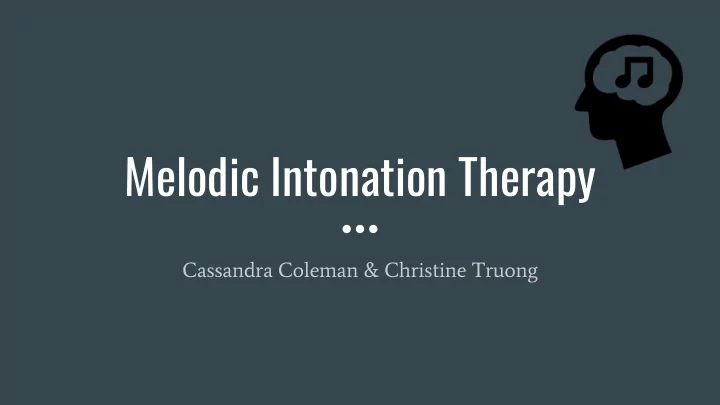

Melodic Intonation Therapy Cassandra Coleman & Christine Truong
What is Melodic Intonation Therapy (MIT)? MIT is “an aphasia treatment method based on the observation that some people with aphasia can ❖ produce real words only when singing familiar songs” (p. 279) It is a hierarchically structured method ➢ The person with aphasia (PWA) ❖ Progresses from melodically intoning meaningful words and phrases in unison with the clinician to ➢ independently producing words and phrases with normal speech prosody The goal of MIT ❖ To stimulate recovery of the person’s propositional language and speech skills for everyday, ➢ functional communication (Helm-Eastabrooks, Albert, Nicholas,2004)
Melodic Intonation Therapy (...continued) MIT uses the musical elements of speech ❖ i.e. melody, rhythm, and stress to improve expressive language ➢ MIT capitalizes on intact functioning (singing) while engaging areas of the undamaged right hemisphere ❖ Most often used to treat individuals with severe, nonfluent aphasia ❖ Individuals begin by intoning (singing) simple phrases and then gradually intoning phrases of increasing ❖ syllable length Visual and tactile cues are given by the clinician, and phrases of social and functional importance to the ❖ individual are practiced Reliance on intonation is gradually decreased over time ➢ (Helm-Eastabrooks et. al 2004) (ASHA)
Candidates & Criteria for MIT Based on research, candidates for this approach demonstrate: ❖ Cause of aphasia is a left- hemisphere stroke ➢ Speech output ➢ Poorly articulated ■ Nonfluent ■ Nonsense stereotype ■ Repetition is poor ➢ Some accurate word production will occur during the singing of familiar songs ➢ Auditory Comprehension is moderately preserved ➢ Indicative of severe Broca’s aphasia ➢ PWA must be: ➢ Alert and well motivated ■ Emotionally stable ■ Good attention span ■ (Helm-Eastabrooks et. al 2004)
Efficacy According to ASHA, overall positive effects were discovered regarding the ❖ usage of MIT to improve verbal production for those with aphasia Level 1b and limited Level 2 evidence suggests MIT improves word retrieval ❖ or performance on comprehensive language assessments as effectively as standard treatment (Teasell, R. W., Foley, N. C., et al. 2016). Evidence on its improvement of repetition is conflicting. ➢ Limited Level 2 evidence suggests MIT improves responsive speech, but not repetition (2016 Module 14; p. 29). Overall, the studies found positive effects for the use of Melodic Intonation ❖ Therapy to improve verbal production in individuals with aphasia. The majority of participants were in the chronic phase of recovery. Further research is warranted as many studies were exploratory case studies or case series pre- and post-test designs (van der Meulen, I., van de Sandt-Koenderman, M. E., et al. 2012). https://www.asha.org/EvidenceMapLanding.aspx?id=8589936279&recentarticles=false&year=undefined&tab=allTab&filters=/8589935906/8589936 279/8589936280/8589936283/,/8589935906/8589936279/8589936280/8589936283/8589936830/8589936841/
Method 3 levels ❖ Level 1 & Level 2 ➢ ■ Multisyllabic words and short, high- probability phrases Level 3 ➢ Longer and more phonologically complex sentences ■
Training: Level 1 1. Humming 2. Unison intoning 3. Unisoning intoning with fading 4. Immediate repetition 5. Response to a probe question
Training: Level 2 1. Introduction of target phrase ● 2. Unison with fading 3. Delayed repetition 4. Response to a probe question
Training: Level 3 1. Delayed repetition ● 2. Introducing sprechgesang or “speech song” 3. Sprechgesang with fading 4. Delayed spoken repetition 5. Response to a probe question
Questions?
References American Speech-Language-Hearing Association | ASHA. (n.d.). Retrieved March 01, 2018, from https://www.asha.org/ Helm-Estabrooks, N., Albert, M. L., & Nicholas, M. (2004). Manual of aphasia and aphasia therapy (Vol. 3). Austin, TX: Pro-ed. http://researchandhope.com/melodic-intonation-therapy/ https://www.asha.org/EvidenceMapLanding.aspx?id=8589936279&recentarticles=false&year=undefined&tab=all Tab&filters=/8589935906/8589936279/8589936280/8589936283/,/8589935906/8589936279/8589936280/8589936 283/8589936830/8589936841/
Recommend
More recommend